1993 BUICK CENTURY wheel
[x] Cancel search: wheelPage 154 of 324
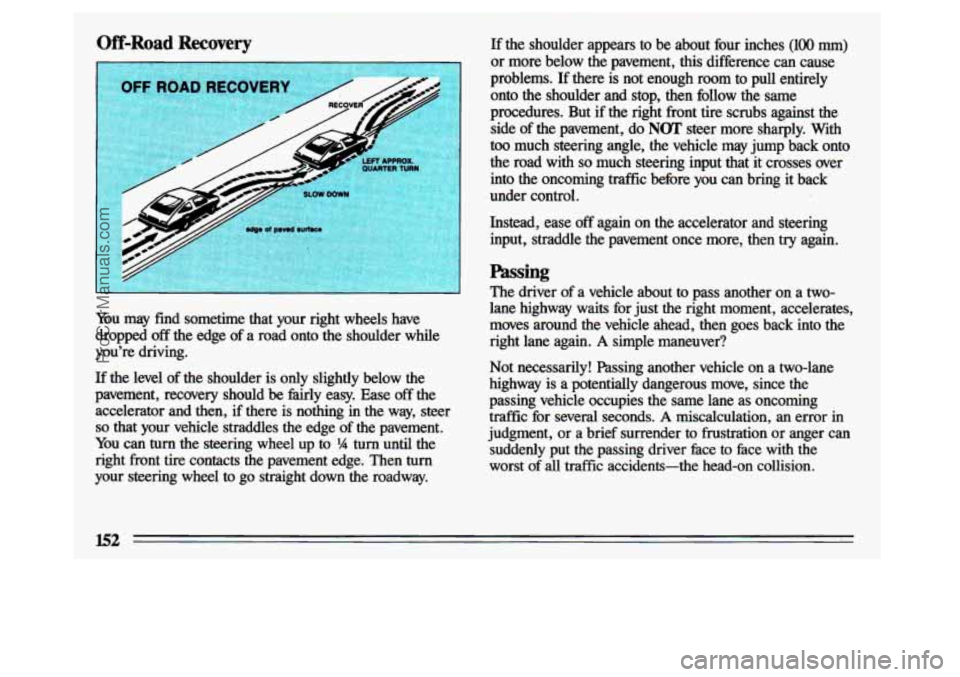
Iff-Road Recovery
You may find sometime that your right wheels have
dropped
off the edge of a road onto the shoulder while
you’re driving.
If the level of
the shoulder is only slightly below the
pavement, recovery should be hirly easy. Ease off the
accelerator and then, if there is nothing in the way, steer
so that your vehicle straddles the edge of the pavement.
You can
turn the steering wheel up to % turn until the
right front tire contacts the pavement edge. Then
turn
your steering wheel to go straight down the roadway.
I
If the shoulder appears to be about four inches (100 mm)
or more below the pavement, this difference can cause
problems. If there
is not enough room to pull entirely
onto the shoulder and stop, then follow the same
procedures. But if the right front tire scrubs against the
side of the pavement, do
NOT steer more sharply. With
too much steering angle, the vehicle may jump back onto
the road with
so much steering input that it crosses over
into the oncoming traffic before you can bring it back
under control.
Instead, ease
off again on the accelerator and steering
input, straddle the pavement once more, then
try again.
passing
The driver of a vehicle about to pass another on a two-
lane highway waits for just the right moment, accelerates,
moves around the vehicle ahead, then goes back into the
right lane again.
A simple maneuver?
Not necessarily! Passing another vehicle on a two-lane
highway is a potentially dangerous move, since the
passing vehicle occupies the same lane as oncoming
traffic for several seconds.
A miscalculation, an error in
judgment, or a brief surrender to frustration or anger can
suddenly put the passing driver face to face with the
worst of all traffic accidents-the head-on collision.
152
ProCarManuals.com
Page 156 of 324
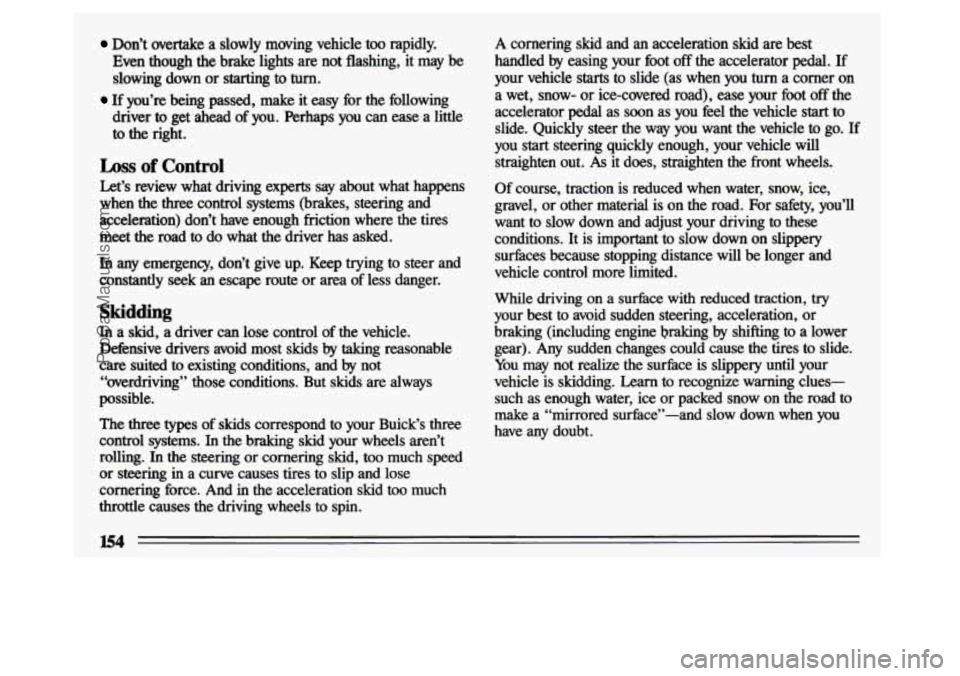
Don’t overtake a slowly moving vehicle too rapidly.
Even though the brake lights are not flashing, it
may be
slowing down or starting to turn.
driver to get ahead of you. Perhaps you can ease a little
to the right.
If you’re being passed, make it easy for the following
Loss of Control
Let’s review what driving experts say about what happens
when the three control systems (brakes, steering and
acceleration) don’t have enough friction where the tires
meet the road
to do what the driver has asked.
In any emergency, don’t give up. Keep trying to steer and
constantly
seek an escape route or area of less danger.
Skidding
In a skid, a driver can lose control of the vehicle.
Defensive drivers avoid most skids
by taking reasonable
care suited
to existing conditions, and by not
“overdriving” those conditions. But skids are always
possible.
The three types
of skids correspond to your Buick‘s three
control systems. In the braking skid your wheels aren’t
rolling.
In the steering or cornering skid, too much speed
or steering in a curve causes tires to slip and lose
cornering force. And
in the acceleration skid too much
throttle causes the driving wheels to spin.
I
A cornering skid and an acceleration skid are best
handled by easing your foot
off the accelerator pedal. If
your vehicle starts to slide (as when you turn a corner on
a wet, snow- or ice-covered road), ease your
foot off the
accelerator pedal as soon as you feel the vehicle start to
slide. Quickly steer the way you want the vehicle to go. If
you
start steering quickly enough, your vehicle will
straighten out. As it does, straighten the front wheels.
Of course, traction is reduced when water, snow, ice,
gravel, or other material is on the road.
For safety, you’ll
want to slow down and adjust your driving
to these
conditions. It is important to slow down on slippery
surfaces because stopping distance will be longer and
vehicle control more limited.
While driving on a surfhce
with reduced traction, try
your best to avoid sudden steering, acceleration, or
braking (including engine braking
by shifting to a lower
gear).
Any sudden changes could cause the tires to slide.
You may not realize the surface is slippery until your
vehicle is skidding.
Learn to recognize warning clues-
such as enough water, ice or packed snow on the road
to
make a “mirrored surface”-and slow down when you
have
any doubt.
154
ProCarManuals.com
Page 157 of 324

In a braking skid (where the wheels are no longer
rolling), release enough pressure on the brakes to get the
wheels rolling again.
This restores steering control. Push
the brake
pedal down steadily when you have to stop
suddenly.
As long as the wheels are rolling, you will have
steering control. Steer the way you want to go.
Driving at Night
Night driving is more dangerous than day driving. One
reason is that some drivers are likely to be impaired-by
alcohol or drugs, with night vision problems, or by fatigue.
Here are some tips on night driving.
Drive defensively. Remember, this is the most
dangerous time.
Don’t drink and drive. (See “Drunken Driving” in the
Index for more on this problem.)
Adjust your inside rearview mirror to reduce the glare
from headlights behind you.
Since you can’t see as well, you may need to slow
down and keep more space between you and other
vehicles. It’s hard to tell how fast the vehicle ahead is
going just by looking at its taillights.
Slow down, especially on higher speed roads. Your
headlights can light up only
so much road ahead.
In remote areas, watch for animals.
If you’re tired, pull off the road in a safe place and rest.
ProCarManuals.com
Page 166 of 324
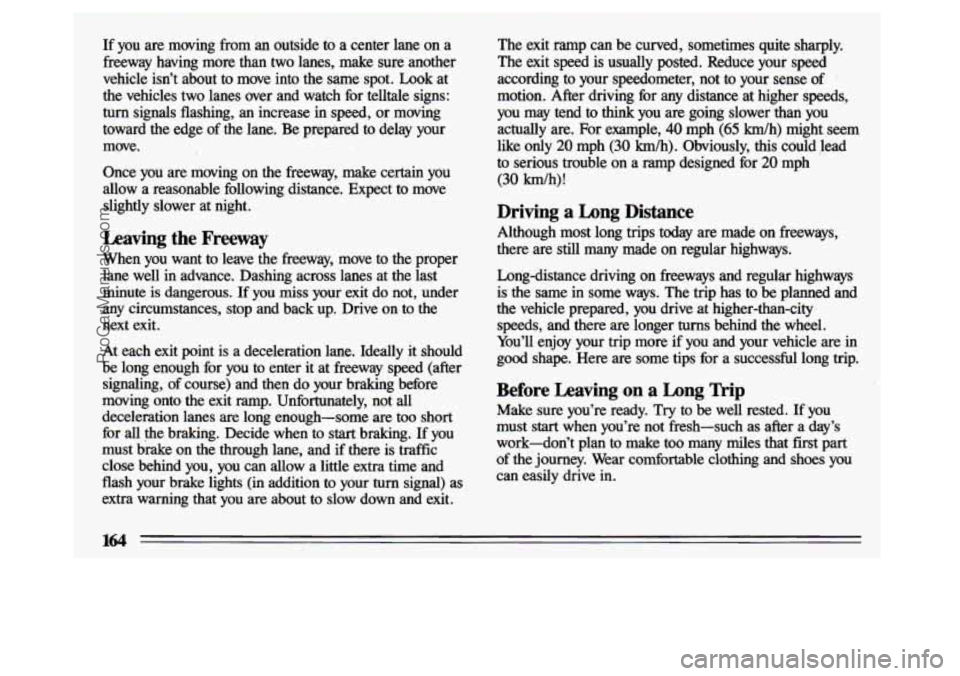
If you are moving from an outside to a center lane on a
freeway, having more than two lanes, make sure another
vehicle isn’t about
to move into the same spot. Look at
the vehicles two lanes over and watch for telltale signs:
turn signals flashing, an increase in speed, or moving
toward the edge of the lane. Be prepared to delay your
move.
Once you are moving on the freeway, make certain you
allow a reasonable following distance. Expect to move slightly slower at night.
Leaving the Freeway
When you want to-leave the freeway, move to the proper
lane well in advance. Dashing across lanes at the last
minute is dangerous.
If you miss your exit do not, under
any circumstances, stop and back up. Drive
on to the
next exit.
At each exit point is a deceleration lane. Ideally it should
be long enough for you to enter it at freeway speed (after
signaling, of course) and then do your braking before
moving onto the exit ramp. Unfortunately, not all
deceleration lanes are long enough-some are too short
for
all the braking. Decide when to start braking. If you
must bkke on the through lane, and if there is traffic
close behind you, you can allow a little extra time and
flash your brake lights (in addition to your
turn signal) as
extra warning that you are about to slow down and exit. The ,exit ramp can be curved, sometimes quite sharply.
The exit
speed is usually posted. Reduce your speed
according to your speedometer, not to your sense of
motion. After driving for any distance at higher speeds,
you may tend to
think you are going slower than you
actually
are. For example, 40 mph (65 km/h) might. seem
like only
20 mph (30 ludh). Obviously, this could lead
to serious trouble on a ramp designed for
20 mph
(30 ludh)!
Driving a Long Distance
Although most long trips today are made on freeways,
there are still many made on regular highways.
Long-distance driving on freeways and regular highways
is
the same in some ways. The trip has to be planned and
the vehicle prepared, you drive at higher-than-city
speeds, and there are longer turns behind the wheel.
You’ll enjoy your trip more if you and your vehicle are in
good shape. Here are some tips for a successful long trip.
Before Leaving on a Long Trip
Make sure you’re ready. Try to be well rested. If you
must start when you’re not fresh-such as after a day’s
work-don’t plan to make too many miles that first part
of the journey. Wear comfortable clothing and shoes you
can easily drive in.
164
ProCarManuals.com
Page 167 of 324
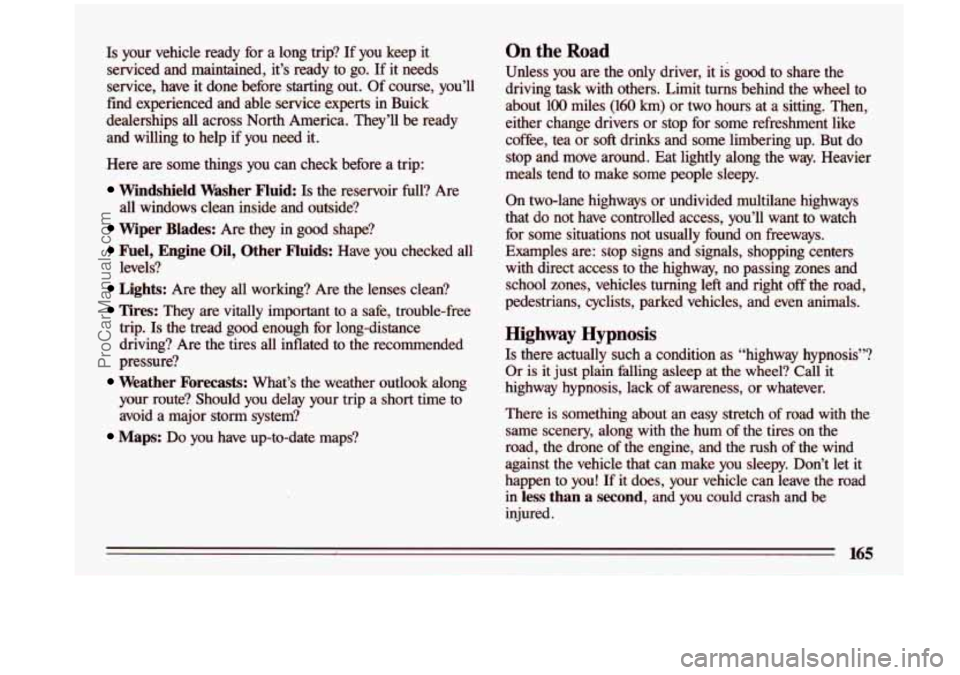
Is your vehicle ready for a long trip? If you keep it
serviced and maintained, it’s ready to go. If it needs
service, have it done before starting out.
Of course, you’ll
find experienced and able service experts in Buick
dealerships
all across North America. They’ll be ready
and willing to help if you need it.
Here are some things you can check before
a trip:
Windshield Washer Fluid: Is the reservoir full? Are
all windows clean inside and outside?
Wiper Blades: Are they in good shape?
hel, Engine Oil, Other Fluids: Have you checked all
Lights: Are they all working? Are the lenses clean?
Tires: They are vitally important to a safe, trouble-free
trip.
Is the tread good enough for long-distance
driving? Are the tires all inflated to the recommended
pressure?
Weather Forecasts: What’s the weather outlook along
your route? Should you delay your trip a short time to
avoid a major storm system?
levels?
Maps: Do you have up-to-date maps?
On the Road
Unless you
are the only driver, it is good to share the
driving task with others. Limit
turns behind the wheel to
about
100 miles (160 km) or two hours at a sitting. Then,
either change drivers or stop for some refreshment like
coffee, tea or
sol3 drinks and some limbering up. But do
stop and move around. Eat lightly along the way. Heavier
meals tend
to make some people sleepy.
On two-lane highways or undivided multilane highways
that do not have controlled access, you’ll want to watch for some situations not usually found on freeways.
Examples are: stop signs and signals, shopping centers
with direct access to the highway, no passing zones and school zones, vehicles turning left and right
off the road,
pedestrians, cyclists, parked vehicles, and even animals.
Highway Hypnosis
Is there actually such a condition as “highway hypnosis”?
Or is it just plain falling asleep at the .wheel? Call it
highway hypnosis, lack of awareness, or whatever.
There is something about an easy stretch
of road with the
same scenery, along with the hum
of the tires on the
road, the drone
of the engine, and the rush of the wind
against the vehicle that can make you sleepy. Don’t let it \
happen to you!
If it does, your vehicle can leave the road
in
less than a second, and you could crash and be
injured.
165
ProCarManuals.com
Page 170 of 324
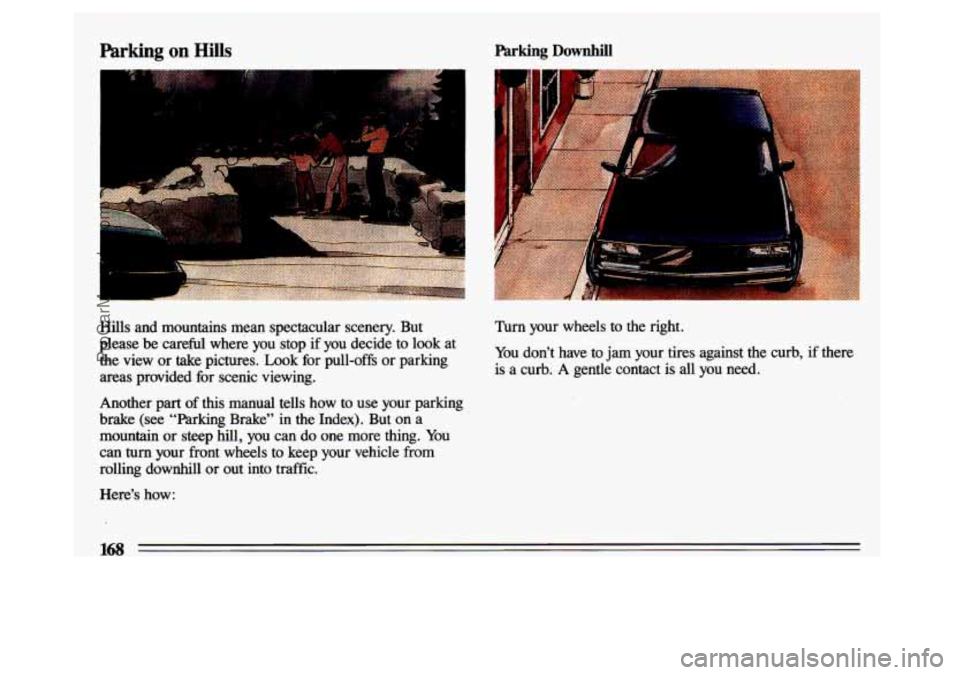
Parking on Hills
-
Parking Downhill
Hills and mountains mean spectacular scenery. But
please be careful where you stop if you decide
to look at
the view or take pictures. Look for pull-offs or parking
areas provided for scenic viewing.
Another part of
this manual tells how to use your parking
brake (see “Parking Brake” in the Index). But on a
mountain or steep hill, you can do one more thing. You
can turn your front wheels to keep your vehicle from
rolling downhill or out into traffic.
Here’s how
:
Turn your wheels to the right.
You don’t have to jam your tires against the curb,
if there
is a curb.
A gentle contact is all you need.
168
ProCarManuals.com
Page 171 of 324
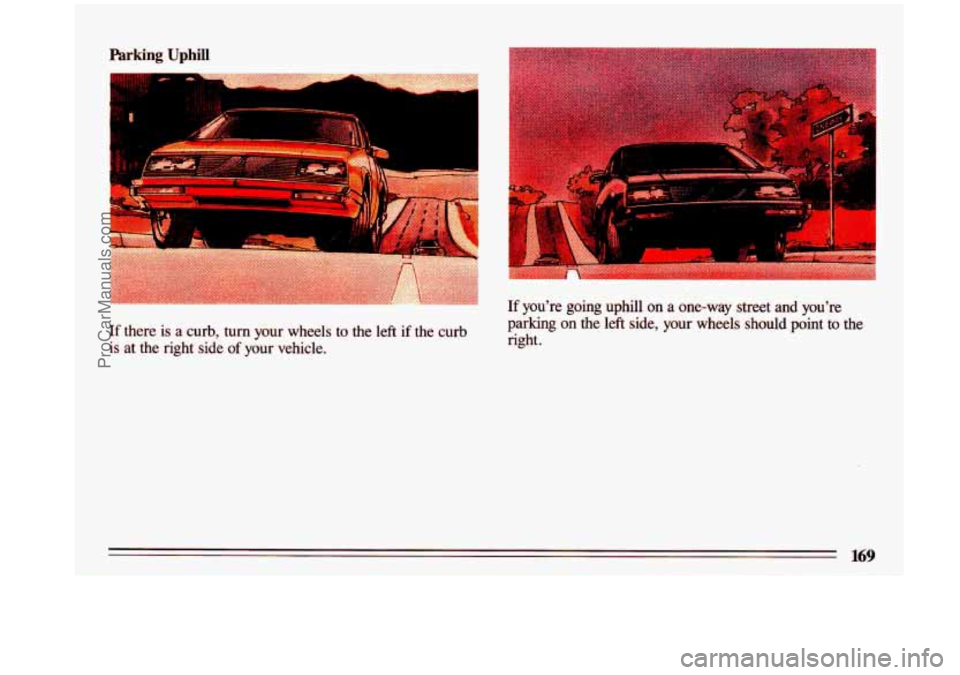
If there is a curb, turn your wheels to the left if the curb
is at
the right side of your vehicle. parking
on the left side, your wheels should point to the
right.
ProCarManuals.com
Page 172 of 324
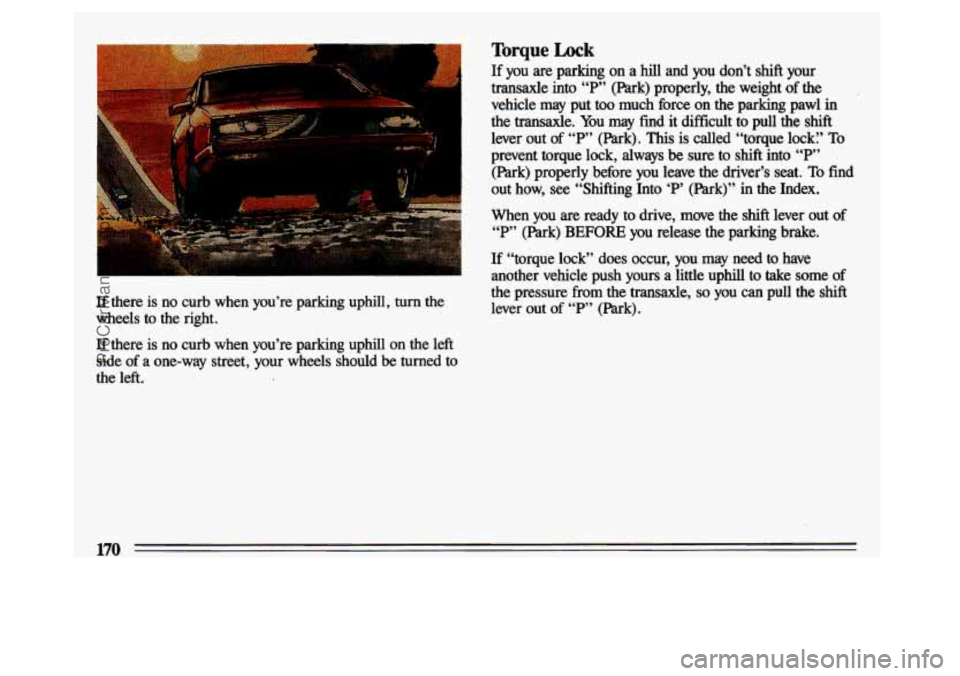
If there is no curb when you’re parking uphill, turn the
wheels to the right.
If there is no curb when you’re parking uphill on the left
side of
a one-way street, your wheels should be turned to
the left.
Torque Lock
If you are parking on a hill and you don’t shift your
transaxle into
“P” mk) properly, the weight of the
vehicle may put
too much force on the parking pawl in
the transaxle. You may find it difficult to pull the shift
lever out of “I”’ (Park). This is called “torque lock:’ To
prevent torque lock, always be sure to shift into “P”
(Park) properly before you leave the driver’s seat. To find
out how, see “Shifting Into ‘P’ (Park)” in the Index.
When you are ready
to drive, move the shift lever out of
“P” (Park) BEFORE you release the parking brake.
If “torque lock” does occur, you may need to have
another vehicle push yours a little uphill to take some of
the pressure from the transaxle,
so you can pull the shift
lever out of “P” (Park).
170
ProCarManuals.com